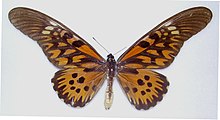Papilio antimachus
| African giant swallowtail | |
|---|---|

| |
| Male, upperside | |
| Scientific classification | |
| Kingdom: | |
| Phylum: | |
| Class: | |
| Order: | |
| Family: | |
| Genus: | |
| Species: | Papilio antimachus
|
| Binomial name | |
| Papilio antimachus | |
| Synonyms | |
| |
Papilio antimachus, the African giant swallowtail, is a butterfly in the family Papilionidae. With a wingspan between 18 and 23 centimetres (7.1 and 9.1 in), it is the largest butterfly in Africa and among the largest butterflies in the world. The wings are long and narrow and the ground colour is orange brown with black markings. P. antimachus live in the tropical rainforests of west and central Africa. The distribution area (range) stretches from Angola, Cameroon, Democratic Republic of the Congo, Republic of the Congo, Gabon, Ghana, Ivory Coast, Liberia, Nigeria, Sierra Leone, and Uganda. The male is larger than the female and can be seen in groups at nectar. The females show themselves less, continually flying high above the tree tops. The butterfly has no natural enemies because it is very toxic.

Subspecies
- Papilio antimachus antimachus (Guinea, Sierra Leone, Liberia, Ivory Coast, Ghana, Togo, southern Nigeria, Cameroon, Gabon, Congo, Central African Republic, western Democratic Republic of the Congo, southern Sudan, northern Angola)
- Papilio antimachus parva Jackson, 1956 (eastern Democratic Republic of the Congo, Uganda)[2]
References
- ^ Papilio, Site of Markku Savela
- ^ Afrotropical Butterflies: File C – Papilionidae - Tribe Papilionini
External links
- Butterflycorner Images from Naturhistorisches Museum Wien
- Tropical and subtropical moist broadleaf forests - WWF Terrestrial Ecoregions

